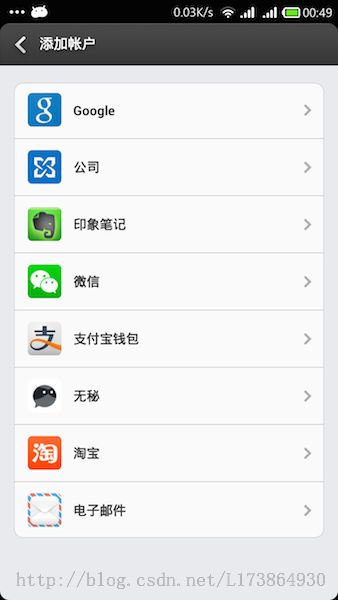Android LaunchAnyWhere (Google Bug 7699048)漏洞详解及防御措施
开始
近日,Google修复一个组件安全的漏洞LaunchAnyWhere(Google Bug 7699048)。这个漏洞属于Intend Based提取漏洞,攻击者利用这个漏洞,可以突破了应用间的权限隔离,达到调用任意私有Activity(exported为false)的目的。
该漏洞影响Android 2.3至4.3固件。
漏洞分析
在分析这个漏洞之前,需要先介绍两个东西。
Account管理机制
从Android2.0开始,系统引入了Account管理机制,详细使用说明见Android官方文档。Account管理机制提供了集中化管理帐户API以及安全存储用户口令和令牌的功能。系统中,可以同时存在多个帐户(设置——添加帐户可以查看),比如Google、Miscrosoft Exchange、微信、支付宝、陌陌等等
Account机制涉及AuthenticationService和Client两个组成元素,它们之间的的通讯统一由AccountManagerService调度,AccountManagerService是Android上的一个系统服务。当Client首次使用时,会向AuthenticationService发起addAccount请求,示意图如下:
最后AuthenticationService会把指定的Intent返回给Client,Client则通过startActivityForResult对最终结果进行处理。这部分源码比较有趣,我们先看看AccountManager.addAccount的代码:
public AccountManagerFuture<Bundle> addAccount(final String accountType,
final String authTokenType, final String[] requiredFeatures,
final Bundle addAccountOptions,
final Activity activity, AccountManagerCallback<Bundle> callback, Handler handler) {
if (accountType == null) throw new IllegalArgumentException("accountType is null");
final Bundle optionsIn = new Bundle();
if (addAccountOptions != null) {
optionsIn.putAll(addAccountOptions);
}
optionsIn.putString(KEY_ANDROID_PACKAGE_NAME, mContext.getPackageName());
return new AmsTask(activity, handler, callback) {
public void doWork() throws RemoteException {
mService.addAccount(mResponse, accountType, authTokenType,
requiredFeatures, activity != null, optionsIn);
}
}.start();
}
最后代码是通过一个AmsTask调用addAccount的,而AmsTask本身是一个异步任务,mRespone是一个Binder对象,当AuthenticationService指定Intent后,就是把intent保存到这个respone对象里,最后看看这个Respone的源码:
/** Handles the responses from the AccountManager */
private class Response extends IAccountManagerResponse.Stub {
public void onResult(Bundle bundle) {
Intent intent = bundle.getParcelable(KEY_INTENT);
if (intent != null && mActivity != null) {
// since the user provided an Activity we will silently start intents
// that we see
mActivity.startActivity(intent);
// leave the Future running to wait for the real response to this request
} else if (bundle.getBoolean("retry")) {
try {
doWork();
} catch (RemoteException e) {
// this will only happen if the system process is dead, which means
// we will be dying ourselves
}
} else {
set(bundle);
}
}
public void onError(int code, String message) {
if (code == ERROR_CODE_CANCELED || code == ERROR_CODE_USER_RESTRICTED) {
// the authenticator indicated that this request was canceled, do so now
cancel(true /* mayInterruptIfRunning */);
return;
}
setException(convertErrorToException(code, message));
}
}
从代码可见,Respone直接帮我们startActivity了。
关于System用户
在Android中,可以说System用户拥有相当高的权限,通过阅读源码可以发,所有permissoin的地方都是直接放行System用户的,见代码ActivityManagerService.checkComponentPermission
/**
* This can be called with or without the global lock held.
*/
int checkComponentPermission(String permission, int pid, int uid,
int owningUid, boolean exported) {
// We might be performing an operation on behalf of an indirect binder
// invocation, e.g. via {@link #openContentUri}. Check and adjust the
// client identity accordingly before proceeding.
Identity tlsIdentity = sCallerIdentity.get();
if (tlsIdentity != null) {
Slog.d(TAG, "checkComponentPermission() adjusting {pid,uid} to {"
+ tlsIdentity.pid + "," + tlsIdentity.uid + "}");
uid = tlsIdentity.uid;
pid = tlsIdentity.pid;
}
if (pid == MY_PID) {
return PackageManager.PERMISSION_GRANTED;
}
return ActivityManager.checkComponentPermission(permission, uid,
owningUid, exported);
}
可见system用户可以完全无视权限检查,不管组件是否为exported,最后都直接返回PERMISSION_GRANTED。
漏洞分析
通过上面对Account机制和System用户的分析,接下来进入主题吧。
在常规情况下,当某个Client发起addAccount请求时,AuthenticationService一般会返回一个指向同包下的Activity(系统提供了基类AccountAuthenticatorActivity),这个Activity主要负责完成帐户和密码的输入交互。
然而,理论上这个AuthenticationService是可以随意指定Intent的,比如指定其他包下的Activity。由于最终startActivity的调用发生在Client进程,因此AuthenticationService是可以调起所有Client能够打开的Activity,当然包含Client自身的exported为false的Activity了。
但Client往往只是一般用户,这种用途价值并不高。幸好系统的Setting帐户相关的功能,提供了一些可以利用的逻辑。漏洞利用原理:想办法令Setting调用addAccount方法,EvilAuthenService就可以指定任意的Intent,由于startActivity的调用发生在Setting,因此就具备了System用户的所有权限了。
通过下面代码, 我们可以直接让Setting发起一个AddAccount请求:
Intent intent = new Intent();
intent.setComponent(new ComponentName("com.android.settings", "com.android.settings.accounts.AddAccountSettings"));
intent.setAction(Intent.ACTION_RUN);
intent.setFlags(Intent.FLAG_ACTIVITY_NEW_TASK);
String authTypes[] = {Constants.ACCOUNT_TYPE};
intent.putExtra("account_types", authTypes);//authType需要指定
AuthenticatorActivity.this.startActivity(intent);
利用示意图如下:
漏洞利用
LaunchAnyWhere漏洞,如果结合其他的漏洞,效果会非常惊艳。
结合Fragment注入漏洞,直接修改屏幕密码
Fragment注入漏洞详解见我之前的博客《Android框架攻击之Fragment注入》。这个漏洞目前大部分厂商已经修复了,但如果再配合LaunchAnyWhere漏洞,那么Fragment注入漏洞修复就形同虚设了。这里把Fragment注入漏洞利用的关键代码贴出来:
Intent intent = new Intent();
intent.setFlags(Intent.FLAG_ACTIVITY_CLEAR_TASK);
intent.setClassName("com.android.settings", "com.android.settings.Settings");
intent.putExtra(":android:show_fragment","com.android.settings.ChooseLockPassword$ChooseLockPasswordFragment");
intent.putExtra("confirm_credentials", false);
startActivity(intent);
漏洞利用POC, 见https://github.com/retme7/launchAnyWhere_poc_by_retme_bug_7699048
结合FakeID漏洞,实现InjectAnyWhere
FakeID漏洞详解见我之前的博客《Android FakeID(Google Bug 13678484) 漏洞详解》。
FakeID漏洞利用的关键让目标进程运行Webview控件,加载Flash控件达到程序注入的目的。通过LaunchAnyWhere漏洞,我们可以直接打开目标进程的Webview。
FakeID和LaunchAnyWhere完美结合的做法是在一个APK中同时集成两个漏洞利用,大致过程如下:
- EvilApp首先令Setting产生一AddAccount请求,并把accountType指定EvilApp本身处理;
- EvilApp创建Intent,并把Intent指向攻击应用Webview的Activity(如微信的com.tencent.mm.plugin.webview.ui.tools.ContactQZoneWebView),url指向某个有flash元素的网页;
- 由于FakeID,WebView则会加载EvilApp中so,注入完毕;
- 在so中再直接加载EvilApp.apk文件,实现Java注入,这部分更详细的内容,见我之前的博客《攻击的Android注入术》;
漏洞修复
这个漏洞在4.4上已经修复,看看修复的代码,可以找到防御的思路:
public void onResult(Bundle result) {
mNumResults++;
- if (result != null && !TextUtils.isEmpty(result.getString(AccountManager.KEY_AUTHTOKEN))) {
+ Intent intent = null;
+ if (result != null
+ && (intent = result.getParcelable(AccountManager.KEY_INTENT)) != null) {
+ /*
+ * The Authenticator API allows third party authenticators to
+ * supply arbitrary intents to other apps that they can run,
+ * this can be very bad when those apps are in the system like
+ * the System Settings.
+ */
+ PackageManager pm = mContext.getPackageManager();
+ ResolveInfo resolveInfo = pm.resolveActivity(intent, 0);
+ int targetUid = resolveInfo.activityInfo.applicationInfo.uid;
+ int authenticatorUid = Binder.getCallingUid();
+ if (PackageManager.SIGNATURE_MATCH !=
+ pm.checkSignatures(authenticatorUid, targetUid)) {
+ throw new SecurityException(
+ "Activity to be started with KEY_INTENT must " +
+ "share Authenticator's signatures");
+ }
+ }
+ if (result != null
+ && !TextUtils.isEmpty(result.getString(AccountManager.KEY_AUTHTOKEN))) {
String accountName = result.getString(AccountManager.KEY_ACCOUNT_NAME);
String accountType = result.getString(AccountManager.KEY_ACCOUNT_TYPE);
if (!TextUtils.isEmpty(accountName) && !TextUtils.isEmpty(accountType)) {
@@ -2223,6 +2276,7 @@
super(looper);
}
由于 Resopne是一个Binder对象,因此当onResult被回调时,可以通过Binder.getCallingUid()获取authenticatorUid,如果targetUid跟authenticatorUid不相同,则直接对AuthenticationService抛异常。
防御措施
应用自身的防御措施是保证expotred为false的Activity不被意外调起。我们通过添加一些检查点,比如B是一个expotred为fase的Activity,按正常逻辑,Activity的堆栈顺序是:
- A1->B->C1
- A2->B->C2
那么我们就可以在A1和A2中设置一检查点,当进入B时,发现检查点没有设置,则认为B被非法调起。沿着这个思路,如果我们把Activity的调用堆栈都记录下来,那么当进入B前,当前栈必然只能是A1或者A2,否则则认为B被非法调起。
Activity堆栈管理的一个实现,可以参考这里http://www.apkbus.com/blog-117210-44386.html


